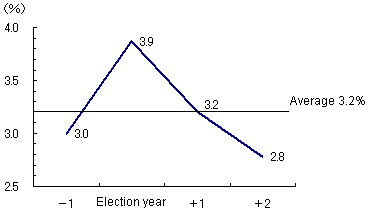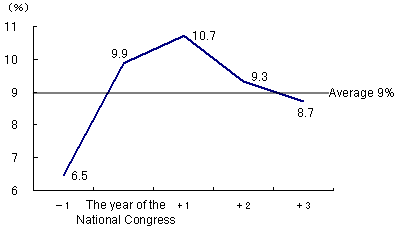At the 16th National Congress of the Communist Party of China, held in autumn 2002, there were major changes in party leaders. This was followed by personnel shake-ups at various levels of the government, and "building an all-round well-off society" was newly targeted as the goal of economic development. This triggered an investment boom across China, and signs of overheating became apparent by the second half of 2003, prompting Chinese authorities to take tightening measures to cool down the economy. As this episode illustrates vividly, the ups and downs of the Chinese economy are highly affected by political factors, and exhibit characteristics of the so-called "political business cycle."
The theory of political business cycle was first put forward by William Nordhaus who observed the relationship between the presidential election and the business cycle in the United States. Thus the ruling party implements expansionary macroeconomic policies to stimulate the economy for their reelection, contributing to the boom phase of the business cycle in the election year. However, such a macroeconomic policy is basically unsustainable, and the bust comes after the election as the government reverses gear. However, the next boom comes just prior to the next election due to the implementation of another round of expansionary policies to boost the economy. In fact, data since 1976 show that the U.S. economy has followed a four-year business cycle, in which the economic growth rate is highest in the election year and lowest two years after the election ( figure 1 ).
Under the current political structure in China, politicians are not elected by general elections, but still data from the past three decades show that the business cycle is strongly associated with the timetable of the National Congress of the Communist Party, which is held every five years ( figure 2 ). During 1976-2003, economic growth averaged 9.9% in the year of the National Communist Party Congress and 10.7% in the year that followed. These numbers are substantially higher than the annual average of 9.0% for the period as a whole. However, during the following three years (before the next Congress was held), the rate declined to 9.3%, 8.7% and 6.5% respectively. Thus there is a strong tendency for the economic growth rate to reach the peak in the year following the National Congress, and to hit the bottom in the year preceding it. This trend seems to have intensified in recent years.
The reason behind this is that as influential leaders who belonged to the revolutionary generations have gone, politicians find it necessary to seek support from the public. They are thus tempted to implement expansionary economic policies during the power transition period. Another reason is that much weight is placed on economic performance as a criterion for promoting officials at the local level. However, although expansionary fiscal and easy monetary policies boost economic growth in the short run, the resulting rise in inflation forces Chinese authorities to take tightening measures sooner or later, leading to the economic slowdown that follows.
Based on this theory, China, which is now experiencing its sixth cycle since 1976, is heading towards an economic slowdown. However, an upturn is expected in 2007 when the 17th National Congress of the Communist Party will be held. Then the business cycle is likely to reach its peak in the following year, 2008, when the Olympics will also be held in Beijing. In this way, the "political business cycle" is useful not only for explaining the historical pattern, but also as a tool for predicting future economic performance.
Figure 1: Relationship between U.S. business cycle and U.S. presidential election

(Note) Average growth rate from 1976 to 2003
(Source) U.S. Bureau of Economic Analysis
Figure 2: Relationship between Chinese business cycle and the timetable of the national party congress

(Note) Average growth rate from 1976 to 2003
The National Congress of the Communist Party is held in every 5 years; the last congress (16th National Congress) was held in November 2002.
(Source) U.S. Bureau of Economic Analysis


